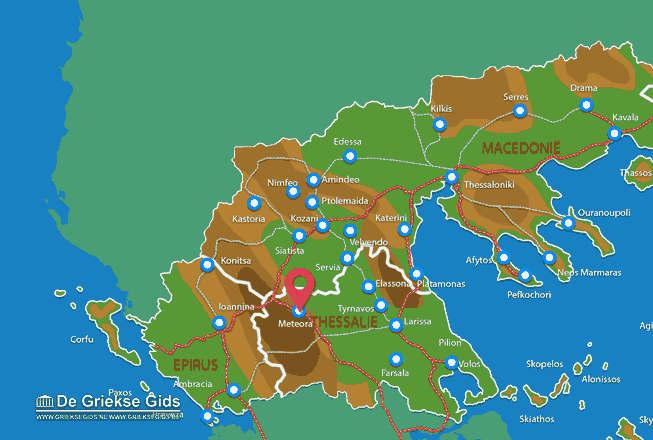Meteora - Trikala (Greece)
METEORA. Meteora is one of the most outstanding monuments of the world, protected by UNESCO, and most important in Thessaly. It is the most notable monastic centre of Greece, after the Holy Mount Athos, .
In the 11th century, the first hermits came to the peaks of the imposing rocks and built the "Skiti" of Doupiani. In the 14th century St. Athanasios Meteoritis formed the first organized monastic community on the rock of Megalo (big) Meteoro. Twenty-four monasteries have spread over the rocks since then, in more than 600 years.
Today only exist the monasteries Megalo Meteoro, Varlaam, Agia Triada, Agios Stefanos and Agios Nikolaos Anapafsas Rousanou and they are still in use. Every day visitors from around the world come together to meditate and pray. They get to know the life of the monks, admire the indescribable nature, the artistic architecture and study the historical relics. The area is characterized by the monasteries built on high rocky pillars. By centuries of wind - and water erosion (the Plain of Thessaly was once an inland sea), the rock formations have received their specific appearance. From the 9th century the natural sandstone towers were climbed by hermits. They created their own environment and only occasionally came down.
From the 11th century onwards elsewhere expelled monks to the area. Mid-14th century rose the first monasteries on the peaks. In 1336 founded the monk Athanasios, from Mount Athos, the Great Meteoron, the highest (623 m) and most important monastery would be founded here. 23 other monasteries would follow. With nets to ropes and wooden ladders up to 40 meters in length the monks transport needed goods and people upstairs. In its heyday, there was an autonomous community of 24 monks and monasteries in almost complete isolation from the rest of the world. Since 1490 the abbot of the Great Meteoron was also the head of the entire monastic community of Meteora. In the 17th century, however, began the decline of monasticism in Meteora. In the 18th century the monasteries were used as a refuge for the Greeks who wanted to evade taxes imposed by the Turkish rulers. During the 19th century the Meteora- monasteries were used to escape advancing rebels, and during the Second World War and the Civil War (1945-1949), the then remaining monasteries suffered much damage.
Photo Gallery Meteora - Photos of Meteora
Video Meteora
The monasteries
After all these centuries of violence, there are only six monasteries left in reasonable condition, some of which are still inhabited by monks and nuns. Since 1988 the Meteora World Heritage did much effort to restore the monasteries in their original glory.
1 Saint Nikolaos Anapafsas (St Nicholas)
2.Mega meteoron (Great Meteoron)
3 Varlaam
4 Rousanou
5 Agia Triada (Holy Trinity)
6 Agios Stefanos, (H. Steven)
Weather forecast Meteora (Trikala)
Meteora in other languages
Trikala: Where on the map is Meteora located?




 Meteora (GriekseGids.nl)
Meteora (GriekseGids.nl) Meteora (GriekseGids.be)
Meteora (GriekseGids.be) Meteora (JustGreece.com)
Meteora (JustGreece.com)